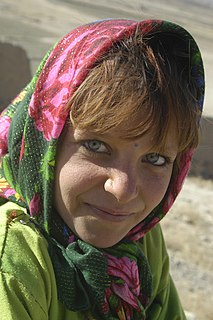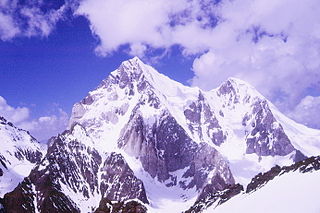
Afghanistan is a landlocked mountainous country located within South Asia. It is also sometimes included as part of the Middle East or Central Asia. The country is the 40th largest in the world in size. Kabul is the capital and largest city of Afghanistan, located in the Kabul Province. Strategically located at the crossroads of major trade routes, Afghanistan has attracted a succession of invaders since the sixth century BCE.

The Himalayas, or Himalaya are a mountain range in Asia separating the plains of the Indian subcontinent from the Tibetan Plateau. The range has some of the planet's highest peaks, including the highest, Mount Everest. Over 100 peaks exceeding 7,200 m (23,600 ft) in elevation lie in the Himalayas. By contrast, the highest peak outside Asia is 6,961 m (22,838 ft) tall.

The Hindu Kush, historically known as Uparisyena in Sanskrit, is an 800-kilometre-long (500 mi) mountain range that stretches through Afghanistan, from its centre to Northern Pakistan and into Tajikistan. The range forms the western section of the Hindu Kush Himalayan Region (HKH); at its eastern end it leads to the Pamir Mountains on the north, and the Karakoram and the Himalayas to the east and south. It divides the valley of the Amu Darya to the north from the Indus River valley to the south. The range has numerous high snow-capped peaks, with the highest point being Tirich Mir or Terichmir at 7,708 metres (25,289 ft) in the Chitral District of Khyber Pakhtunkhwa, Pakistan. To the north, near its northeastern end, the Hindu Kush buttresses the Pamir Mountains near the point where the borders of China, Pakistan and Afghanistan meet, after which it runs southwest through Pakistan and into Afghanistan near their border. The eastern end of the Hindu Kush in the north merges with the Karakoram Range. Towards its southern end, it connects with the Spin Ghar Range near the Kabul River.

The Indomalayan realm is one of the eight biogeographic realms. It extends across most of South and Southeast Asia and into the southern parts of East Asia.

The Nuristanis, also known as Kafiristanis, are an ethnic group native to the Nuristan Province of northeastern Afghanistan, whose languages comprise the Nuristani branch of Indo-Iranian languages. A small community of Nuristanis are also settled in the neighbouring Chitral region of the Khyber Pakhtunkhwa province of Pakistan.

The Alpine orogeny or Alpide orogeny is an orogenic phase in the Late Mesozoic (Eoalpine) and the current Cenozoic that has formed the mountain ranges of the Alpide belt.

Baintha Brakk or The Ogre is a steep, craggy mountain, 7,285 metres (23,901 ft) high, in the Panmah Muztagh, a subrange of the Karakoram mountain range. It is located in Gilgit-Baltistan, Pakistan. It is famous for being one of the hardest peaks in the world to climb: twenty-four years elapsed between the first ascent in 1977 and the second in 2001.

The Buni Zom group is a prominent mountain area of Chitral, in the Hindu Raj range of Pakistan. Buni Zom (main) is the highest peak of the group with an elevation of 6,542 m (21,463 ft). It is located about 50 km (30 mi) northeast of the town of Chitral, and about 50 km (30 mi) east of Tirich Mir, the highest peak in the Hindu Kush.

Falak Sar is the highest mountain peak in Ushu Valley of Swat, Pakistan at an elevation of 5,957 metres (19,544 ft), it is considered the highest peak of the Swat district in the Hindu Kush mountains range, followed by Mankial mountain peak.

Koyo Zom is the highest peak in the Hindu Raj mountain range in Pakistan at 6,872 metres (22,546 ft). The Hindu Raj mountain range sits between the Hindu Kush in the west and the Karakoram in the east.

Kush generally refers to a pure or hybrid Cannabis indica strain. Pure C. indica strains include Afghan Kush, Hindu Kush, Green Kush, and Purple Kush. Hybrid strains of C. indica include Blueberry Kush and Golden Jamaican Kush.

Glacier growing, artificial glaciation or glacier grafting, is a practice carried out in the Hindu Kush and Himalaya regions aimed at creating small new glaciers to increase water supply for crops and in some cases to sustain micro hydro power. In order to encourage the growth of a glacier local farmers acquire ice from naturally occurring glaciers, and carry it to high altitude areas where the ice is put inside a small cave dug out in a scree-slope. Along with the ice other ingredients such as water, salt, sawdust, wheat husks and charcoal are also placed at the site. The use of glacier grafting is an old skill of the mountain farmers of Baltistan and Gilgit, where it is used for irrigation purposes since at least the 19th century. This technique was described by Lieutenant David Lockhart Robertson Lorimer (1876–1962) in the 1920s. Allegedly glacier grafting also has been used to block mountain passes.

Patricius is a Palearctic genus of butterflies in the family Lycaenidae.

Turanana is a genus of butterflies in the family Lycaenidae. It is found in the east Palearctic from Greece to Central Asia.

The Indian subcontinent, or simply the subcontinent, is a physiographical region in South Asia. It is situated on the Indian Plate and projecting southwards into the Indian Ocean from the Himalayas. Geopolitically, the Indian subcontinent generally includes Bangladesh, Bhutan, India, Nepal, Pakistan and Sri Lanka, as well as the Maldives. Geologically, the Indian subcontinent is related to the landmass that rifted from the supercontinent Gondwana during the Cretaceous and merged with the Eurasian landmass nearly 55 million years ago. Geographically, it is the peninsular region in South-Central Asia, delineated by the Himalayas in the north, the Hindu Kush in the west, and the Arakanese in the east. The terms Indian subcontinent and South Asia are sometimes used interchangeably to denote the region, although the term South Asia usually also includes Afghanistan.

Takthok Monastery is a Buddhist monastery in Sakti village in Ladakh, northern India, located approximately 46 kilometres east of Leh. It is the only monastery in Ladakh belonging to the Nying-ma-pa or Red Hat sect. The name Takthok, literally meaning 'rock-roof' was named because both its roof as well as walls are made up of rock. It belongs to the Nyingma tradition of Tibetan Buddhism and approximately 55 lamas reside there. It is the only Nyingma monastery in Ladakh.

Chazara heydenreichi is a butterfly species belonging to the family Nymphalidae. It can be found from Hindu Kush and the W. Himalaya across Middle Asia and Kazakhstan to the S. Altai.

Kalasha Dur Museum also known as Bamborate Museum located in Chitral District, Khyber Pakhtunkhwa, Pakistan. The Kalasha Dur Museum construction work started in 2001 and was completed in 2005. There are about 1300 objects exhibited which are of Ethnological interest from the Kalasha Tradition and from the traditions of the wider Hindu Kush area.



















